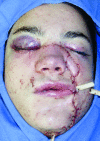Facial gunshot wounds: trends in management
- PMID: 22110801
- PMCID: PMC3052666
- DOI: 10.1055/s-0029-1202595
Facial gunshot wounds: trends in management
Abstract
Facial gunshot wounds, often comprising significant soft and bone tissue defects, pose a significant challenge for reconstructive surgeons. Whether resulting from assault, accident, or suicide attempt, a thorough assessment of the defects is essential for devising an appropriate tissue repair and replacement with a likely secondary revision. Immediately after injury, management is centered on advanced trauma life support with patient stabilization as the primary goal. Thorough examination along with appropriate imaging is critical for identifying any existing defects. Whereas past surgical management advocated delayed definitive treatment using serial debridement, today's management favors use of more immediate reconstruction. Recent advances in microsurgical technique have shifted favor from local tissue advancement to distant free flap transfers, which improve cosmesis and function. This has resulted in a lower number of surgeries required to achieve reconstruction. Because of the diversity of injury and the complexity of facial gunshot injuries, a systematic algorithm is essential to help manage the different stages of healing and to ensure that the best outcome is achieved.
Keywords: Facial gunshot wounds; management; reconstruction.
Figures







Similar articles
-
Contemporary issues in facial gunshot wound management.J Craniofac Surg. 2008 Mar;19(2):421-7. doi: 10.1097/SCS.0b013e31816ae4a8. J Craniofac Surg. 2008. PMID: 18362720
-
Facial Gunshot Wounds.Facial Plast Surg. 2019 Dec;35(6):578-583. doi: 10.1055/s-0039-1700879. Epub 2019 Nov 29. Facial Plast Surg. 2019. PMID: 31783412
-
High-energy ballistic and avulsive facial injuries: classification, patterns, and an algorithm for primary reconstruction.Plast Reconstr Surg. 1996 Sep;98(4):583-601. doi: 10.1097/00006534-199609001-00001. Plast Reconstr Surg. 1996. PMID: 8773681
-
Gunshot wounds to the head and neck.Curr Opin Otolaryngol Head Neck Surg. 2007 Aug;15(4):213-8. doi: 10.1097/MOO.0b013e3281fbd3ef. Curr Opin Otolaryngol Head Neck Surg. 2007. PMID: 17620893 Review.
-
[Treatment strategies for gunshot wounds of the extremities].Unfallchirurg. 2008 Apr;111(4):247-54; quiz 255. doi: 10.1007/s00113-008-1436-6. Unfallchirurg. 2008. PMID: 18368383 Review. German.
Cited by
-
What Will it Take? Plastic Surgery's Small but Powerful Role in Reducing Gun Violence.Plast Reconstr Surg Glob Open. 2022 Dec 16;10(12):e4714. doi: 10.1097/GOX.0000000000004714. eCollection 2022 Dec. Plast Reconstr Surg Glob Open. 2022. PMID: 36569248 Free PMC article. No abstract available.
-
Same-Admission Microvascular Maxillofacial Ballistic Trauma Reconstruction Using Virtual Surgical Planning: A Case Series and Systematic Review.Craniomaxillofac Trauma Reconstr. 2022 Sep;15(3):206-218. doi: 10.1177/19433875211026432. Epub 2021 Jun 21. Craniomaxillofac Trauma Reconstr. 2022. PMID: 36081679 Free PMC article.
-
Treatment Strategies in the Management of Maxillofacial Ballistic Injuries in Low-Intensity Conflict Scenarios.J Maxillofac Oral Surg. 2018 Dec;17(4):466-481. doi: 10.1007/s12663-018-1089-0. Epub 2018 Feb 2. J Maxillofac Oral Surg. 2018. PMID: 30344389 Free PMC article.
-
Penetrating foreign body in the masticator space with injury to the internal maxillary artery: a surgical challenge.Ann R Coll Surg Engl. 2016 Nov;98(8):e194-e196. doi: 10.1308/rcsann.2016.0239. Epub 2016 Aug 23. Ann R Coll Surg Engl. 2016. PMID: 27551898 Free PMC article.
-
Management of Maxillofacial Gunshot Injuries With Emphasis on Damage Control Surgery During the Yemen Civil War. Review of 173 Victims From a Level 1 Trauma Hospital in Najran, Kingdom of Saudi Arabia.Craniomaxillofac Trauma Reconstr. 2022 Mar;15(1):58-65. doi: 10.1177/19433875211012211. Epub 2021 Apr 30. Craniomaxillofac Trauma Reconstr. 2022. PMID: 35265279 Free PMC article.
References
-
- Doctor V S, Farwell D G. Gunshot wounds to the head and neck. Curr Opin Otolaryngol Head Neck Surg. 2007;15:213–218. - PubMed
-
- Yuksel F, Celikoz B, Ergun O, et al. Management of maxillofacial problems in self-inflicted rifle wounds. Ann Plast Surg. 2004;53:111–117. - PubMed
-
- Motamedi M H. Primary treatment of penetrating injuries to the face. J Oral Maxillofac Surg. 2007;65:1215–1218. - PubMed
-
- Thorne C H. Gunshot wounds to the face: current concepts. Clin Plast Surg. 1992;19:233–244. - PubMed
-
- Hollier L, Grantcharova E P, Kattash M. Facial gunshot wounds: a 4-year experience. J Oral Maxillofac Surg. 2001;59:277–282. - PubMed
LinkOut - more resources
Full Text Sources
Miscellaneous
